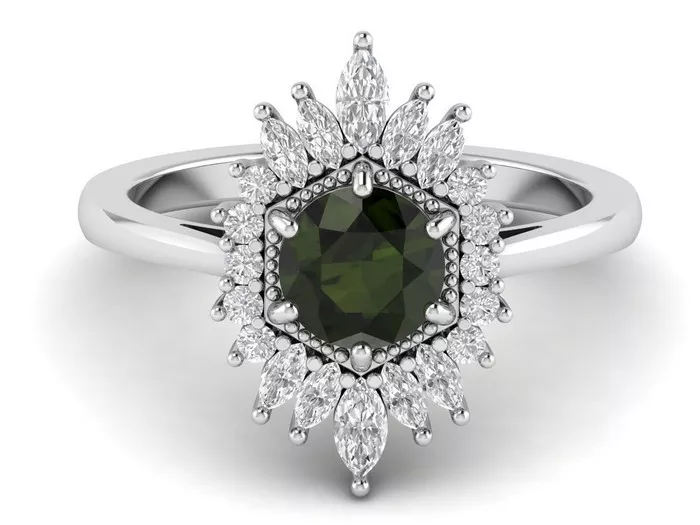Moldavite, with its captivating green hue and mysterious origin, has intrigued collectors, enthusiasts, and spiritual seekers for centuries. Believed to possess metaphysical properties and hailed as a stone of transformation, moldavite has gained popularity in recent years. However, its rising demand has also led to an influx of counterfeit and fake products flooding the market. Thus, the need to distinguish genuine moldavite from imitations is paramount for both buyers and sellers alike.
In this comprehensive guide, we delve into the various aspects of moldavite authentication, equipping you with the knowledge and tools necessary to discern real moldavite from its synthetic or counterfeit counterparts.
Understanding Moldavite
Before delving into authenticity verification methods, it’s essential to grasp what moldavite is and how it is formed. Moldavite is a rare form of tektite, a naturally occurring glass formed by the impact of meteorites on Earth’s surface. Moldavite’s unique green coloration and distinct surface features are a result of its rapid cooling from a molten state upon impact.
Moldavite is primarily found in the region of southern Bohemia, Czech Republic, although small deposits have been discovered in neighboring countries such as Germany and Austria. Its scarcity, coupled with its association with celestial origins, contributes to its allure and value.
Why Authenticity Matters
The allure of moldavite lies not only in its aesthetic appeal but also in the belief that it possesses powerful energetic properties. As such, many individuals seek out genuine moldavite for its purported healing and transformative effects. However, the market is flooded with counterfeit moldavite, often made from glass or other synthetic materials, which lack the metaphysical properties attributed to the authentic stone.
Moreover, purchasing counterfeit moldavite not only leads to financial losses but also perpetuates unethical practices within the gemstone industry. By learning to identify genuine moldavite, consumers can make informed purchases while supporting ethical sourcing practices.
Key Indicators of Authentic Moldavite
1. Color and Transparency:
Authentic moldavite typically exhibits a distinct shade of green, ranging from pale green to deep forest green. The color is often unevenly distributed throughout the stone, with areas of transparency and opacity. Beware of moldavite that appears too perfect or uniform in color, as this may indicate synthetic or counterfeit material.
2. Surface Texture:
Genuine moldavite features a characteristic pitted or wrinkled surface texture, known as “etching,” resulting from its rapid cooling during formation. These surface features are irregular and often resemble folds or wrinkles, giving the stone a unique tactile quality. Be wary of moldavite with a smooth or polished surface, as it may be artificially created.
3. Natural Inclusions:
Inclusions are natural materials trapped within the moldavite during its formation process and can include tiny bubbles, mineral crystals, or organic matter. While inclusions do not necessarily indicate authenticity on their own, their presence, along with other authenticity indicators, can help confirm the genuineness of moldavite.
4. Fluorescence:
Under ultraviolet (UV) light, authentic moldavite may exhibit a faint green fluorescence, a result of its mineral composition. While fluorescence alone is not a definitive indicator of authenticity, it can serve as an additional confirmation tool when combined with other authentication methods.
5. Specific Gravity and Density:
Genuine moldavite has a specific gravity ranging from 2.32 to 2.38 g/cm³, making it slightly denser than most glass imitations. This difference in density can be measured using a specific gravity testing kit, providing quantitative data to support authenticity claims.
6. Authenticity Certificates:
When purchasing moldavite from reputable dealers or sellers, always inquire about authenticity certificates or documentation. These certificates, issued by gemological laboratories or certified experts, provide assurance of the stone’s authenticity and may include detailed information on its origin, characteristics, and testing methods used.
Conclusion
In the pursuit of genuine moldavite, knowledge is your most valuable asset. By familiarizing yourself with the key indicators of authenticity outlined in this guide, you can confidently navigate the market and make informed purchasing decisions. Remember to exercise caution when encountering suspiciously low-priced moldavite or sellers unwilling to provide authentication documentation.
Ultimately, the allure of moldavite lies not only in its physical beauty but also in the belief in its transformative powers. By ensuring the authenticity of your moldavite specimens, you can embark on a journey of self-discovery and spiritual growth with confidence, knowing that you hold a genuine piece of cosmic history in your hands.
FAQs
What are some common signs of counterfeit moldavite?
Counterfeit moldavite often lacks the natural surface texture and irregularities found in genuine specimens. It may appear too perfect or uniform in color and may exhibit a smooth, polished surface. Additionally, counterfeit moldavite may lack the characteristic fluorescence seen in authentic moldavite under UV light.
What should I do if I suspect my moldavite is counterfeit?
If you suspect that your moldavite may be counterfeit, refrain from making any assumptions until you have gathered sufficient evidence. Consider seeking a second opinion from gemological experts or certified appraisers who can conduct thorough authenticity assessments. Additionally, you may contact the seller or manufacturer for clarification and recourse options.
Are there any reputable sources for purchasing authentic moldavite?
Yes, reputable sources for purchasing authentic moldavite include established gemstone dealers, certified gemological laboratories, and reputable online marketplaces with stringent authenticity verification processes. When purchasing moldavite, always inquire about authenticity certificates or documentation to ensure the legitimacy of your purchase.
What steps can I take to protect myself from purchasing counterfeit moldavite?
To protect yourself from purchasing counterfeit moldavite, educate yourself about the key indicators of authenticity outlined in this guide. Purchase from reputable dealers or sellers who provide authenticity certificates and have a transparent sourcing process. Additionally, be wary of deals that seem too good to be true and always exercise due diligence before making a purchase.

